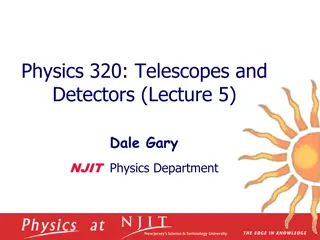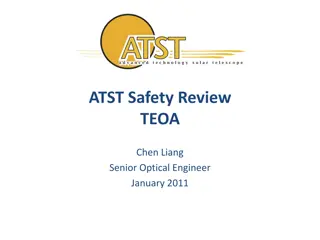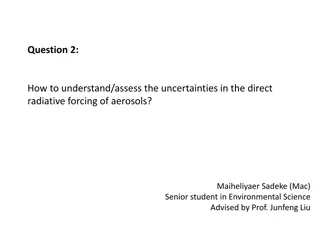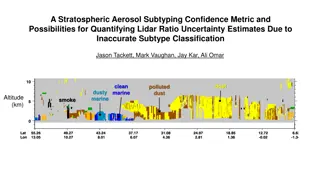Light Optical Aerosol Counter (LOAC) Project Overview
Light Optical Aerosol Counter (LOAC) is a project led by Jean-Baptiste Renard in France, involving a collaboration between research institutions, private companies, and the French Space Agency. The LOAC instrument, weighing 1 kg, is used with meteorological balloons to measure concentrations of aerosols in various size classes. It employs two scattering angles for accurate sizing and counting of particles, providing real-time stray light correction. Calibrated for irregular particles, LOAC can detect the nature of particles but is not suitable for perfect solid spheres. The project aims to determine the main nature of particles through speciation analysis.
Download Presentation

Please find below an Image/Link to download the presentation.
The content on the website is provided AS IS for your information and personal use only. It may not be sold, licensed, or shared on other websites without obtaining consent from the author.If you encounter any issues during the download, it is possible that the publisher has removed the file from their server.
You are allowed to download the files provided on this website for personal or commercial use, subject to the condition that they are used lawfully. All files are the property of their respective owners.
The content on the website is provided AS IS for your information and personal use only. It may not be sold, licensed, or shared on other websites without obtaining consent from the author.
E N D
Presentation Transcript
LOAC (Light Optical Aerosol Counter) Jean-Baptiste RENARD (LPC2E-CNRS, Orl ans, France)
Light Optical Aerosols Counter Project funded by the Agence Nationale de la Recherche Collaboration between national research laboratory (LPC2E, LSCE/CEA, LA), private companies (Environnement-SA, Aerophile SAS, MeteoModem), and the French Space Agency 90 copies produced at the end of 2014 50 scientific flights under different kinds of balloons
Instrument and pump: 350 g Electric consumption: ~3 W No lenses => no risk of misalignment Concentrations for 19 size classes between 0.2 and 100 m Automatic check every 10 minutes and electronic recalibration if necessary (ex. strong changes in temperature) Total weigh (gondola, batteries and LOAC): 1 kg for use with meteo balloons
Principle of measurements 2 scattering angles measurements (field of view of few degrees) ~12 , insensitive to the refractive index of the particles (mainly diffraction) => accurate size determination and counting ~60 , strongly sensitive to the refractive index of the particles => indication of the nature of the particles Detection of the maximum of intensity for particle that crosses the laser beam Real-time stray light correction
Calibrated with beads and real irregular particles Similar statistical approach for the detection of irregular particles (all natural solid particles are irregular) At a given diameter, same scattered flux for different natures of particles (at small scattering angles) LOAC can be used for liquid and irregular particles but not for perfect solid spheres
Small field of view (few degrees) at small scattering angles => large irregular particles are less luminous than expected Confirmation by modelling (Mie) calculations including a roughness surface coefficient
Determination of the main nature of the particles: Speciation The 60 measurements are very sensitive to the refractive index of the particles More absorbing are the particles, lower are the scattered flux The 60 size distribution is often lower than the 12 real size distribution The ratio of the 2 size distributions varies with the nature of the particles
The 12/60 ratio is compared to charts obtained in laboratory for different families of particles: - Liquid droplets - Minerals - Carbons This is an open data base and other natures of particles can be considered (no more than 3 or 4 different natures)
Pollution carbon particles Saharan sand plume Size distribution Size distribution speciation speciation
Sea salt Inside a cloud Size distribution Size distribution speciation speciation
LOAC is used at ground and under all kinds of balloons: tethered, meteo, low troposphere, stratosphere Modular instrument : LOAC can work with different kinds of pump (between 1.3 and 2.7 l/mn) and with different kinds of inlets depending on the sampling conditions
Beginning of the fog Permanent measurements at ground in the south sunburn of Paris to study fog events End of the fog Welas and Fog Monitor : optical counters
Permanent measurements on board the touristic balloon AOG in Paris, from ground to an altitude of 250 m Strong pollution event on 11 December 2013 and inversion layer at an altitude of 200 m Close to the ground, various natures At 200m, black carbon
Counting measurements can be converted to PM 2.5 and PM10 mass ( g/m3) Mean densities used from speciation results: 1.4 g/cm3for carbon 2.2 g/cm3for minerals and salts 0 g/cm3for droplets (small changes in case of humidity > 65%) Comparison with microbalance measurements from AirParif ambient air network Very good agreement
LOAC has performed 19 flight under BPCL (long duration tropospheric balloons) and BLD (Meteo balloon) during the Charmex campaign, summer 2013, above the Mediterranean Sea BPCL trajectory on 17 June 2013, altitude of 2000 m
Flight inside a Saharan sand plume Detection of large particles Particles transported during several days No sedimentation Indirect detection of strong electro-magnetic field inside the plume
Vertical profiles of aerosol content with BLD (meteo) balloons 17 June 2013, Minorca 23 June 2014, Ury (France) Liquid particles Liquid droplets + soot Sand plume Cirrus
Fly on-board Unmanned Airborne Vehicles (Fly-N-Sense Society) Environmental studies, analysis of local sources
CONCLUSIONS LOAC can provide size distribution and main nature of the aerosols Light instrument for ground and airborne measurements Now a commercial instrument Actual scientific campaigns: Pollution studies in the Paris region (ground, tethered balloon) VOLTAIRE, long-term monitoring of the stratosphere (~25 flights per year at different latitudes)
Future Improved version of LOAC in development STRATEOLE, long duration balloons (several months) in the lower equatorial stratosphere (coordinated by LMD-CNRS) LOAC for space application (CNES) : Studies of planetary atmospheres Earth Saturn Titan Mars
Contact for science application: jbrenard@cnrs-orleans.fr LOAC is commercialized by the MeteoModem company: http://www.meteomodem.com LOAC on board Unmanned Airborne Vehicles is commercialized by the Fly-N-Sense company : http://www.fly-n-sense.com/























